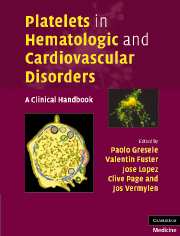Book contents
- Frontmatter
- Contents
- List of contributors
- Preface
- Glossary
- 1 The structure and production of blood platelets
- 2 Platelet immunology: structure, functions, and polymorphisms of membrane glycoproteins
- 3 Mechanisms of platelet activation
- 4 Platelet priming
- 5 Platelets and coagulation
- 6 Vessel wall-derived substances affecting platelets
- 7 Platelet–leukocyte–endothelium cross talk
- 8 Laboratory investigation of platelets
- 9 Clinical approach to the bleeding patient
- 10 Thrombocytopenia
- 11 Reactive and clonal thrombocytosis
- 12 Congenital disorders of platelet function
- 13 Acquired disorders of platelet function
- 14 Platelet transfusion therapy
- 15 Clinical approach to the patient with thrombosis
- 16 Pathophysiology of arterial thrombosis
- 17 Platelets and atherosclerosis
- 18 Platelets in other thrombotic conditions
- 19 Platelets in respiratory disorders and inflammatory conditions
- 20 Platelet pharmacology
- 21 Antiplatelet therapy versus other antithrombotic strategies
- 22 Laboratory monitoring of antiplatelet therapy
- 23 Antiplatelet therapies in cardiology
- 24 Antithrombotic therapy in cerebrovascular disease
- 25 Antiplatelet treatment in peripheral arterial disease
- 26 Antiplatelet treatment of venous thromboembolism
- Index
10 - Thrombocytopenia
Published online by Cambridge University Press: 15 October 2009
- Frontmatter
- Contents
- List of contributors
- Preface
- Glossary
- 1 The structure and production of blood platelets
- 2 Platelet immunology: structure, functions, and polymorphisms of membrane glycoproteins
- 3 Mechanisms of platelet activation
- 4 Platelet priming
- 5 Platelets and coagulation
- 6 Vessel wall-derived substances affecting platelets
- 7 Platelet–leukocyte–endothelium cross talk
- 8 Laboratory investigation of platelets
- 9 Clinical approach to the bleeding patient
- 10 Thrombocytopenia
- 11 Reactive and clonal thrombocytosis
- 12 Congenital disorders of platelet function
- 13 Acquired disorders of platelet function
- 14 Platelet transfusion therapy
- 15 Clinical approach to the patient with thrombosis
- 16 Pathophysiology of arterial thrombosis
- 17 Platelets and atherosclerosis
- 18 Platelets in other thrombotic conditions
- 19 Platelets in respiratory disorders and inflammatory conditions
- 20 Platelet pharmacology
- 21 Antiplatelet therapy versus other antithrombotic strategies
- 22 Laboratory monitoring of antiplatelet therapy
- 23 Antiplatelet therapies in cardiology
- 24 Antithrombotic therapy in cerebrovascular disease
- 25 Antiplatelet treatment in peripheral arterial disease
- 26 Antiplatelet treatment of venous thromboembolism
- Index
Summary
INTRODUCTION
This chapter focuses on the immune, nonimmune, acquired, and hereditary thrombocytopenias. In particular, it covers immune thrombocytopenic purpura (ITP) and alloimmune thrombocytopenia (AIT) in the fetus and newborn. However, an attempt is made to discuss all of the clinically significant thrombocytopenias. References to more detailed reviews and to specific articles in certain areas are provided. Areas that would benefit from additional research are highlighted as well.
IMMUNE THROMBOCYTOPENIC PURPURA
After chemotherapy-induced thrombocytopenia, ITP is among the most common causes of acquired thrombocytopenia. It has been estimated to affect approximately 1 in 10 000 in the general population, about half of whom are children, and to account for 0.18% of hospital admissions. ITP is caused by autoreactive antibodies that bind to platelets, shorten their life span, and, in an unknown percentage of cases, impair platelet production.
The clinical presentation of ITP varies from the acute onset of severe thrombocytopenia and important mucosal bleeding to the discovery of mild asymptomatic thrombocytopenia during evaluation of another illness or on a routine checkup. ITP can occur as an isolated, “idiopathic” condition or it may accompany other systemic disorders, such as systemic lupus erythematosus (SLE) or chronic lymphocytic leukemia. Considerable progress has been made in understanding the pathophysiology of ITP. Several new treatment modalities have been introduced during the past 5 to 10 years.
- Type
- Chapter
- Information
- Platelets in Hematologic and Cardiovascular DisordersA Clinical Handbook, pp. 155 - 185Publisher: Cambridge University PressPrint publication year: 2007



